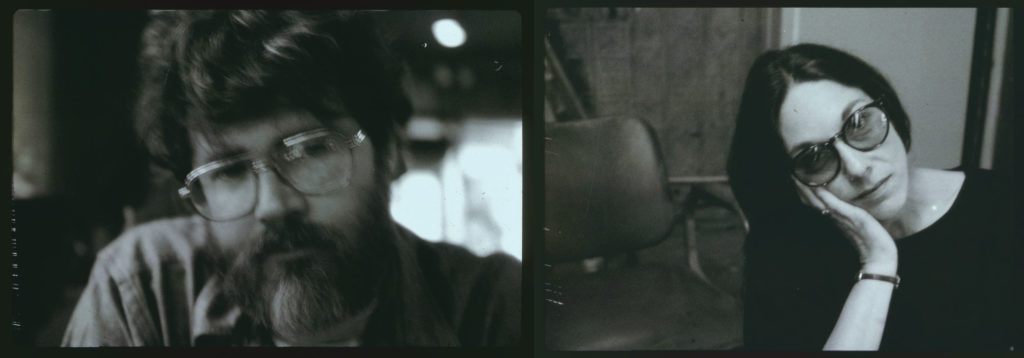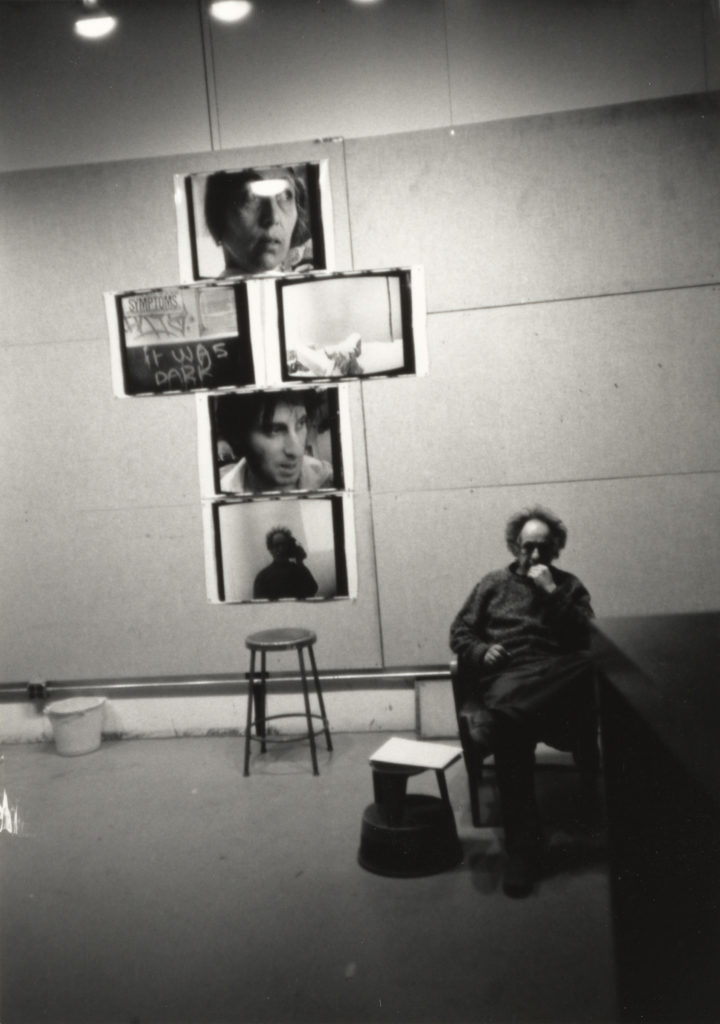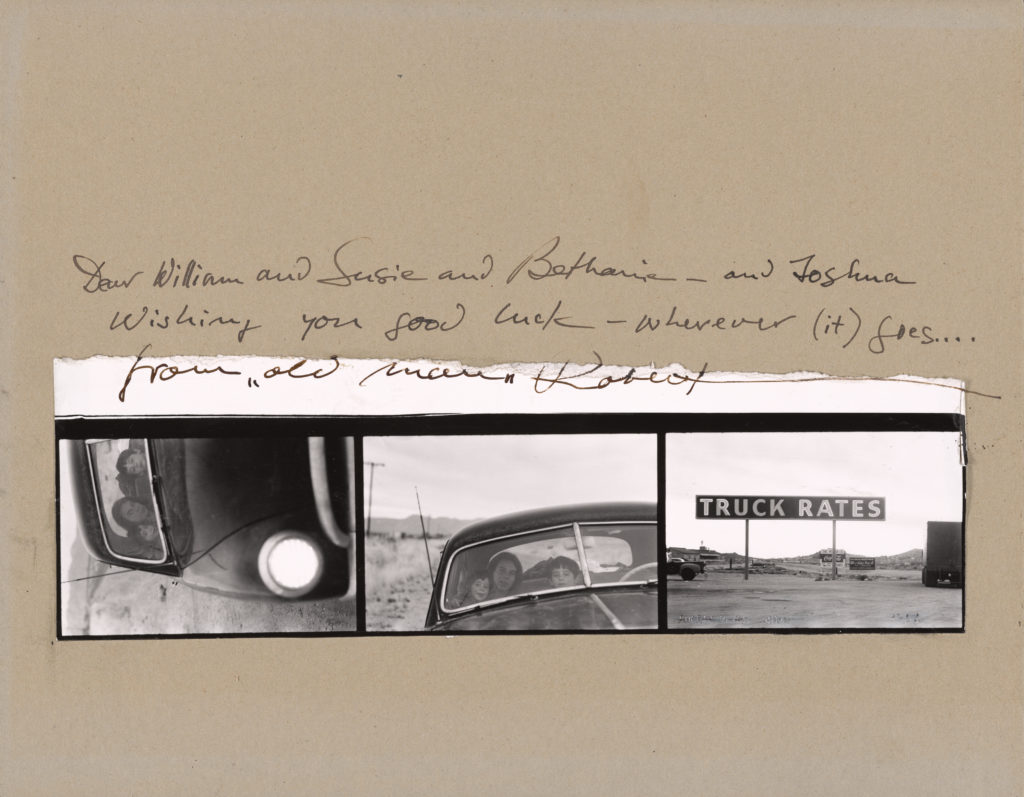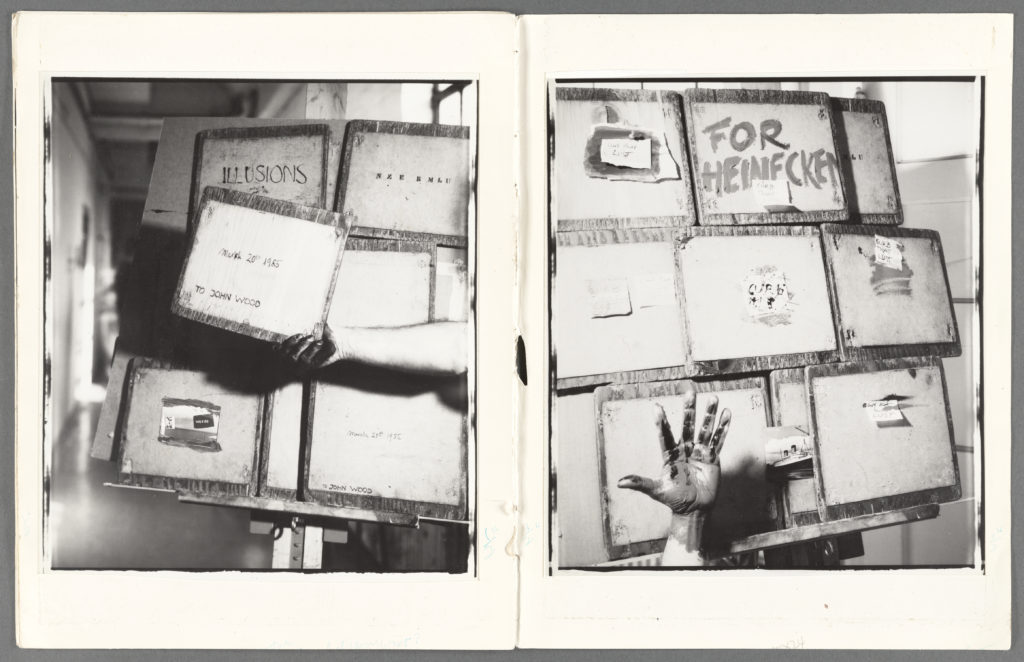Thirty-eight years ago, the art historians Susan E. Cohen and William S. Johnson set out to tackle an ambitious task: to characterize the state of photography at that moment.
In pursuit of their goal, the husband-and-wife team enlisted four well-respected photographers—Robert Frank, Dave Heath, Robert Heinecken, and John Wood—to work on a collaborative project that would ultimately lead to an exhibition. It was relatively unprecedented: At the time, photographers rarely worked together and artists of their stature were unlikely to agree to such an open-ended project.
But Cohen and Johnson managed to convince them, conducting lengthy interviews and observing them in their studios. They also arranged meetings for all four to get together in Rochester, New York—a hotbed for photography at the time, it was home to Kodak and the Visual Studies Workshop, where the show would be held. They even secured funding from the Polaroid Corporation.

Joan Lyons, Are these men collaborators? (1983). Courtesy of the Susan E. Cohen and William S. Johnson Creativity Project Archive, Harry Ransom Center, The University of Texas at Austin. © Joan Lyons.
However, three years into the project and just months prior to the opening of the would-be exhibition, funding was pulled and the whole initiative was suspended. The exhibition was canceled; the artists went back to their lives. Their work was packed away in boxes and stored in Cohen and Johnson’s closet in Massachusetts, unseen for decades. Until now.
Back in the Light of Day
Last month, the Harry Ransom Center at the University of Texas at Austin announced that it had acquired the Susan E. Cohen and William S. Johnson Creativity Project—the work made by the four artists for the show, as well as the accompanying documentation painstakingly gathered and catalogued by the historians. The trove includes 50 hours of audio and video interviews, letters and postcards, rare monographs and maquettes for artists’ books, and a number of other artifacts.

Left: Susan E. Cohen, William at Bubba’s Restaurant, 8th St., NY (1983). © Susan E. Cohen. Right: William S. Johnson, Susie Being Patient, Frank’s Kitchen (1983). © William S. Johnson. Courtesy of the Susan E. Cohen and William S. Johnson Creativity Project Archive, Harry Ransom Center, The University of Texas at Austin.
Curators looking at the project with fresh eyes say it accomplished exactly what it aimed to do: capture a moment in art history and offer a peek into leading photographers’ artistic processes.
“The genesis of the project was 100 percent tied to the context of the late 1970s and early ’80s,” explains Jessica McDonald, the Ransom Center’s curator of photography. McDonald discovered the archive when the historians connected with her about publishing the unfinished catalogue. “It comes after this moment in the ’60s and into the ’70s, when photography shifts from something that’s fully ignored or rejected from art’s official channels—from museums, from critical publications and serials, from universities—to the point where every museum suddenly found a photography department.”
Yet even then, McDonald explains, “it wasn’t unheard of to be at public symposia and have somebody in the audience ask, ‘Well, it’s just a camera, you push the button. How are you an artist?’” This, in a basic sense, was what the artists were trying to accomplish with their participation: “’How can we show that it’s not just that you push the button, you have this picture, and you’re done? That you might think through a project over weeks, months, or even years, and even work on a single print, in the darkroom or through a variety of different means in the studio.’”

William S. Johnson, [Robert Frank in the Polaroid 20 x 24 studio, Boston] (1985). Courtesy of the Susan E. Cohen and William S. Johnson Creativity Project Archive, Harry Ransom Center, The University of Texas at Austin. © William S. Johnson.
Still, the fact that the historians were able to convince these four artists to participate was an impressive feat. After all, the shape and scope of the project was quite loose. And though the four were aware of each other’s work, they weren’t exactly friends. Nor were they necessarily known for collaborating with others—especially Frank, who, by far the biggest name of the group (and the only one still alive today), was known for his reclusiveness. Yet sign on they did, and by January 1983, the artists went to work.
“Three of the four of them were teachers, and I think they saw the benefit of participating in a collaborative and experimental situation because of what could be learned by them and others,” McDonald says. “Plus they all respected each other.”

William S. Johnson, [Robert Heinecken in the Polaroid 20 x 24 studio, Boston] (1983). Courtesy of the Susan E. Cohen and William S. Johnson Creativity Project Archive, Harry Ransom Center, The University of Texas at Austin. © William S. Johnson.
It’s tempting to think of this project’s dormant afterlife as metaphorical—that the fact that it existed in storage boxes for so long, unseen by just about anyone outside of its central creators, is appropriate. You could make the argument that it’s almost like a photograph itself, or a time capsule—an index of a certain time.
But McDonald is less interested in the romanticism of this rediscovered body of work than in the practical lessons it can teach us today. The Ransom is in the process now of cataloging all the materials, after which they’ll be made available to the public for research.

Robert Frank, U.S. 90, en route to Del Rio, Texas (1955). Courtesy of the Susan E. Cohen and William S. Johnson Creativity Project Archive, Harry Ransom Center, The University of Texas at Austin. © Robert Frank.
What can this once-nearly-forgotten project tell us about the state of photography then and how it has evolved since? “That’s really the key question, the reason for acquiring the material,” McDonald says. “And I hope to answer it when I get a chance to look at all of it.”











